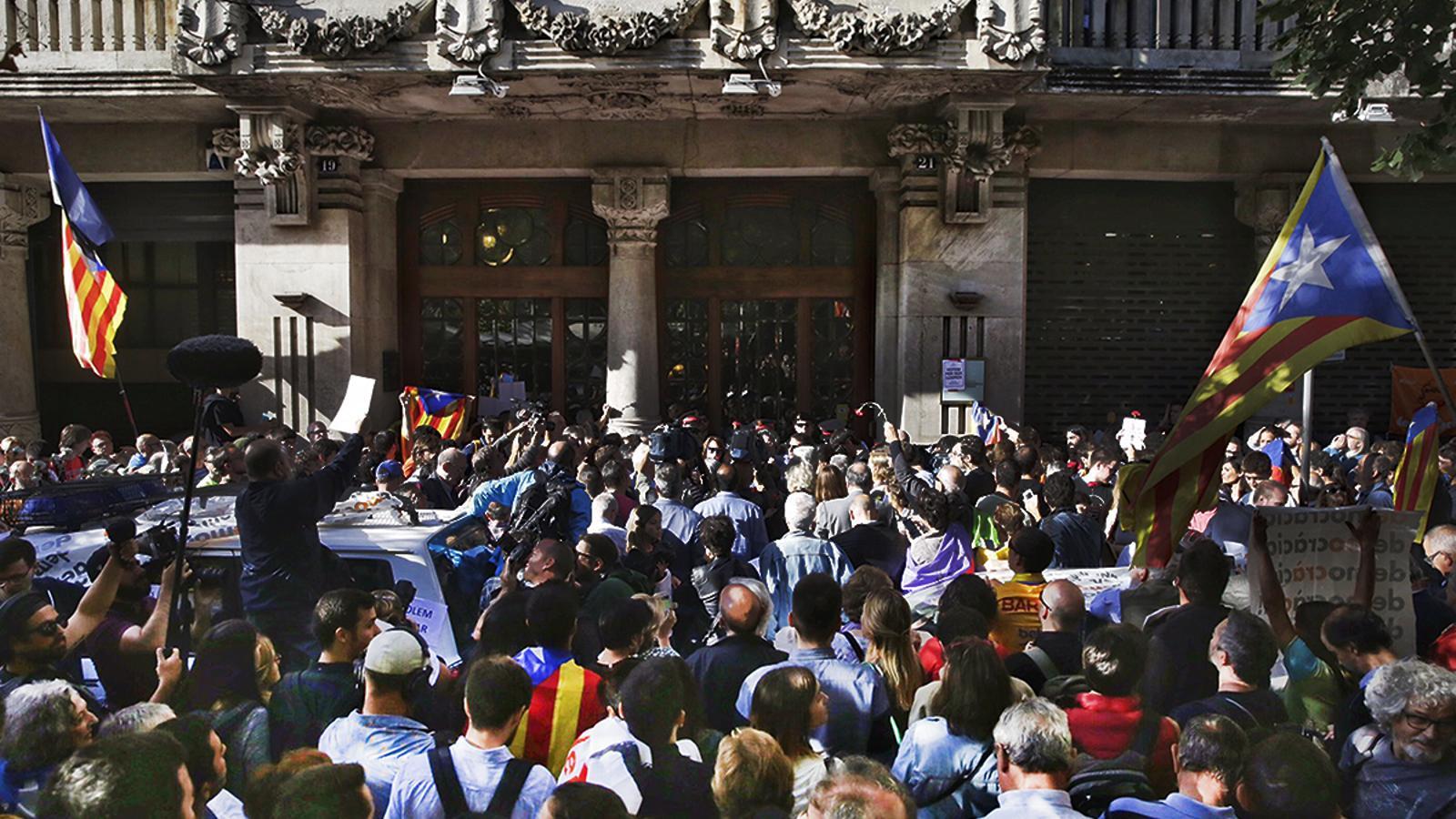CATALONIA
Llarena utiliza un ardid semántico para atribuir rebelión a los dirigentes independentistas
La maniobra del juez puede conllevar penas de entre 10 y 30 años para los encausados
 Concentración espontánea de ciudadanos frente a la 'conselleria' de
Concentración espontánea de ciudadanos frente a la 'conselleria' de
Economía durante la operación de la Guardia Civil contra el 1-O / PERE
VIRGILI
Llarena uses a semantic device to attribute rebellion to the independence leaders
The maneuver of the judge can entail penalties of between 10 and 30 years for the defendants
Pablo
Llarena reconstructs, in his prosecution of 26 politicians and leaders
of the independentist civil society, an alleged legal report that goes
back to 2012, with the victory of Artur Mas in the elections to
Parliament, and that he intends to present a "careful idea "of a
strategy of confrontation with the State.
Although most of the events described were public and notorious, and
were not persecuted at the time by criminal justice - from the creation
of the National Transition Advisory Council, the publication of the White Paper
on the national transition or the approval of resolutions in the
Parliament - according to the story of Llarena, all of them were part of
a conspiracy perfectly organized and that fits in the crimes of
rebellion, disobedience and embezzlement.
In 69 folios, the judge of the Supreme Court makes a detailed account
of each and every one of the main events of Catalan politics, with
special attention to the events of September 20 before the Ministry
of Economy - in which rests its justification for see the violence
necessary for the crime of rebellion - and the referendum on October 1. But Llarena has to invest many folios to justify the risk that leads him to attribute this violence to the defendants.
The magistrate admits that the jurisprudence of the Supreme
"characterizes violence due to his physical nature, his personal
manifestation and his suitability."
That is to say, the violence must be "with physical character", it
demands "the use of force" and must be exercised against "a person". In addition, it is necessary that he has "enough intensity to double the will of the one he is directed against."
Twist the dictionary
None of these assumptions are given in the magistrate's account, which
as violent only indicates the "intimidating capacity" of the masses
assembled on 20-S, points out that Jordi Sánchez and Jordi Cuixart were
placed on two cars of the Civil Guard, and described In detail, the
situation of the injured police officers in the 1-O referendum (taking
responsibility for the congregation before the colleges of this
violence).
Llarena's argument is semantic. Since the facts do not fit in this definition, it establishes a difference between violence and act violently
, that is "who does it violently, which does not present a typical
content that is totally coincident with acting with violence." A twisting of the dictionary that assumes that the adverb violently has a content other than the substantive violence . This, despite the fact that the dictionary of RAE describes violently as a "violently", without further additions.
According to the judge, however, "acting violently" escapes the classic
definition of "violence" used in the courts and does allow "to project
itself on material things."
In the account of the events, Llarena justifies this alleged violence
with the events of the 20-S, in which the "multitude acted as a mass of
force" that "destroyed police vehicles" and "attacked personal assets",
and goes further There, he says, the acts restricted the " ability to act as a result of the use of force," which is compared to "hostage-taking through air shots."
The magistrate admits that violence was not "devised from the beginning
as an instrument for the achievement of independence," but points out
that we must continue to investigate it, and affirms that "the risk of
clearly representative violence" was accepted by encouraging people to
manifest itself despite the deployment of the police forces.
That is to say, again, and as it has already done in other cars,
Llarena is responsible for the police violence to whom they have been
subjected.
Forget 'Focused'
The Enfocats document had become the main test element in the majority of cars issued by Llarena until now.
For the judge, the justification of the participation of the defendants
in the rebellion process rested in the annotations found in this
document powerpoint in the house of number two of Oriol Junqueras in the Ministry of Economy, Josep Maria Jové.
The weakness of this test had been highlighted by the defenses on
several occasions, and Llarena practically forgot about her in the
processing car, instead by placing the White Paper elaborated by the Advisory Council for the National Transition as the touch stone It starts the process and describes the subsequent steps, which would justify talking about a planned and coordinated action. References to Enfocats are now limited to three mentions at the foot of the page.
 Concentración espontánea de ciudadanos frente a la 'conselleria' de
Concentración espontánea de ciudadanos frente a la 'conselleria' de